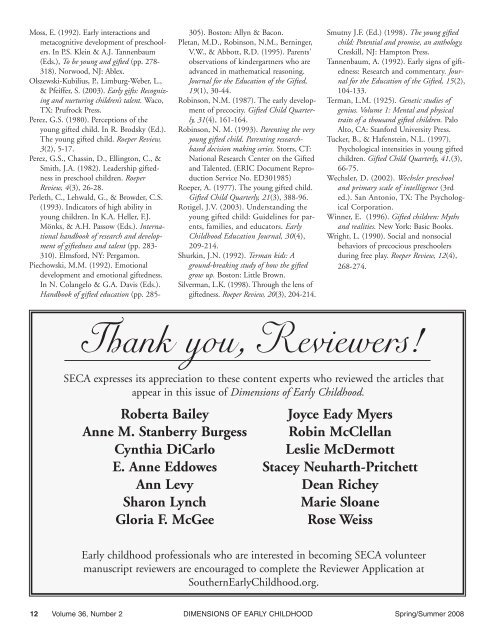Recognizing Giftedness: Defining High Ability in Young Children
Recognizing Giftedness: Defining High Ability in Young Children
Recognizing Giftedness: Defining High Ability in Young Children
You also want an ePaper? Increase the reach of your titles
YUMPU automatically turns print PDFs into web optimized ePapers that Google loves.
Moss, E. (1992). Early <strong>in</strong>teractions and<br />
metacognitive development of preschoolers.<br />
In P.S. Kle<strong>in</strong> & A.J. Tannenbaum<br />
(Eds.), To be young and gifted (pp. 278-<br />
318). Norwood, NJ: Ablex.<br />
Olszewski-Kubilius, P., Limburg-Weber, L.,<br />
& Pfeiffer, S. (2003). Early gifts: <strong>Recogniz<strong>in</strong>g</strong><br />
and nurtur<strong>in</strong>g children’s talent. Waco,<br />
TX: Prufrock Press.<br />
Perez, G.S. (1980). Perceptions of the<br />
young gifted child. In R. Brodsky (Ed.).<br />
The young gifted child. Roeper Review,<br />
3(2), 5-17.<br />
Perez, G.S., Chass<strong>in</strong>, D., Ell<strong>in</strong>gton, C., &<br />
Smith, J.A. (1982). Leadership giftedness<br />
<strong>in</strong> preschool children. Roeper<br />
Review, 4(3), 26-28.<br />
Perleth, C., Lehwald, G., & Browder, C.S.<br />
(1993). Indicators of high ability <strong>in</strong><br />
young children. In K.A. Heller, F.J.<br />
Mönks, & A.H. Passow (Eds.). International<br />
handbook of research and development<br />
of giftedness and talent (pp. 283-<br />
310). Elmsford, NY: Pergamon.<br />
Piechowski, M.M. (1992). Emotional<br />
development and emotional giftedness.<br />
In N. Colangelo & G.A. Davis (Eds.).<br />
Handbook of gifted education (pp. 285-<br />
305). Boston: Allyn & Bacon.<br />
Pletan, M.D., Rob<strong>in</strong>son, N.M., Bern<strong>in</strong>ger,<br />
V.W., & Abbott, R.D. (1995). Parents'<br />
observations of k<strong>in</strong>dergartners who are<br />
advanced <strong>in</strong> mathematical reason<strong>in</strong>g.<br />
Journal for the Education of the Gifted,<br />
19(1), 30-44.<br />
Rob<strong>in</strong>son, N.M. (1987). The early development<br />
of precocity. Gifted Child Quarterly,<br />
31(4), 161-164.<br />
Rob<strong>in</strong>son, N. M. (1993). Parent<strong>in</strong>g the very<br />
young gifted child. Parent<strong>in</strong>g researchbased<br />
decision mak<strong>in</strong>g series. Storrs, CT:<br />
National Research Center on the Gifted<br />
and Talented. (ERIC Document Reproduction<br />
Service No. ED301985)<br />
Roeper, A. (1977). The young gifted child.<br />
Gifted Child Quarterly, 21(3), 388-96.<br />
Rotigel, J.V. (2003). Understand<strong>in</strong>g the<br />
young gifted child: Guidel<strong>in</strong>es for parents,<br />
families, and educators. Early<br />
Childhood Education Journal, 30(4),<br />
209-214.<br />
Shurk<strong>in</strong>, J.N. (1992). Terman kids: A<br />
ground-break<strong>in</strong>g study of how the gifted<br />
grow up. Boston: Little Brown.<br />
Silverman, L.K. (1998). Through the lens of<br />
giftedness. Roeper Review, 20(3), 204-214.<br />
Smutny J.F. (Ed.) (1998). The young gifted<br />
child: Potential and promise, an anthology.<br />
Creskill, NJ: Hampton Press.<br />
Tannenbaum, A. (1992). Early signs of giftedness:<br />
Research and commentary. Journal<br />
for the Education of the Gifted, 15(2),<br />
104-133.<br />
Terman, L.M. (1925). Genetic studies of<br />
genius. Volume 1: Mental and physical<br />
traits of a thousand gifted children. Palo<br />
Alto, CA: Stanford University Press.<br />
Tucker, B., & Hafenste<strong>in</strong>, N.L. (1997).<br />
Psychological <strong>in</strong>tensities <strong>in</strong> young gifted<br />
children. Gifted Child Quarterly, 41,(3),<br />
66-75.<br />
Wechsler, D. (2002). Wechsler preschool<br />
and primary scale of <strong>in</strong>telligence (3rd<br />
ed.). San Antonio, TX: The Psychological<br />
Corporation.<br />
W<strong>in</strong>ner, E. (1996). Gifted children: Myths<br />
and realities. New York: Basic Books.<br />
Wright, L. (1990). Social and nonsocial<br />
behaviors of precocious preschoolers<br />
dur<strong>in</strong>g free play. Roeper Review, 12(4),<br />
268-274.<br />
Thank you, Reviewers!<br />
SECA expresses its appreciation to these content experts who reviewed the articles that<br />
appear <strong>in</strong> this issue of Dimensions of Early Childhood.<br />
Roberta Bailey<br />
Anne M. Stanberry Burgess<br />
Cynthia DiCarlo<br />
E. Anne Eddowes<br />
Ann Levy<br />
Sharon Lynch<br />
Gloria F. McGee<br />
Joyce Eady Myers<br />
Rob<strong>in</strong> McClellan<br />
Leslie McDermott<br />
Stacey Neuharth-Pritchett<br />
Dean Richey<br />
Marie Sloane<br />
Rose Weiss<br />
Early childhood professionals who are <strong>in</strong>terested <strong>in</strong> becom<strong>in</strong>g SECA volunteer<br />
manuscript reviewers are encouraged to complete the Reviewer Application at<br />
SouthernEarlyChildhood.org.<br />
12 Volume 36, Number 2 DIMENSIONS OF EARLY CHILDHOOD Spr<strong>in</strong>g/Summer 2008
















